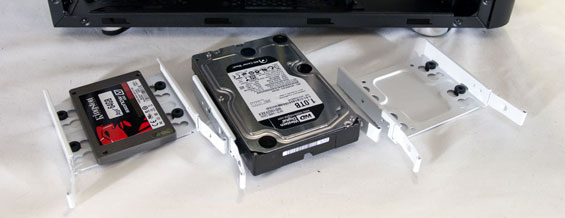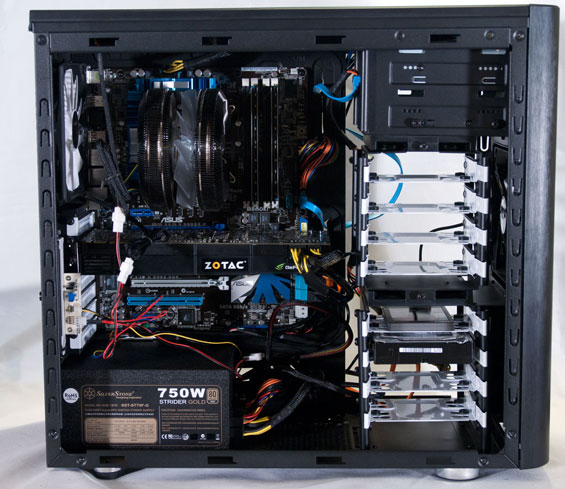Fractal Design Arc Midi: The Mid Tower You've Been Waiting For?
by Dustin Sklavos on October 7, 2011 12:45 AM EST- Posted in
- Cases/Cooling/PSUs
- mid-tower
- Fractal Design
Assembling the Fractal Design Arc Midi
While the Fractal Design Arc Midi does feature a very smart internal design, there are a couple of small conveniences that are missing, the first of which being built in mounting studs for the motherboard. This is a simple thing, but can prove to be a minor nuisance should you ever replace the motherboard: if you don't put the studs in securely the first time, they're liable to join the motherboard when you try to remove it.
Still, getting the motherboard in was easy (as it often is), though routing the AUX 12V cable has been and almost always will be a royal pain. And while it looks like the enclosure is capable of supporting a 240mm radiator, clearance above the motherboard is pretty tight as it is, so I wouldn't recommend it.

None of the drive bays or sleds are tool-less either. This is one area where Corsair has a slight lead, as their plastic drive sleds are actually pretty effective at keeping 3.5" drives in place. At the same time, though, the more traditional drive sleds do come complete with silicon grommets for 3.5" drives, and each sled has mounting holes for 2.5" drives directly in the center of the sled. Getting the hard drive, SSD, and optical drive in was easy enough, it just required a bit of elbow grease and the use of a screwdriver.
Video card clearance even in the native configuration of the top drive cage was also perfectly fine; our GeForce GTX 580 had plenty of breathing room between it and the cage. Getting the power supply in was a breeze too, although it's worth noting that if you use a PSU longer than 170mm you run the risk of covering up the bottom intake fan bay. Most users won't care but it's something to keep in mind.

Getting everything wired up was actually fairly breezy for the most part; the case's interior feels smaller than Corsair's cases which makes things a little more cramped, but it was still easy enough to work with. Where things got cagey was the installation of the expansion slot-based fan controller. My advice here is simple: if your motherboard has decent fan control and enough connectors to support the Arc Midi, just use it instead. The wiring for the fan controller really messes up what would otherwise have been a fairly clean interior. The fan controller has a breakout cable that splits into a molex and three three-pin fan plugs, and I'm not sure there's any good place to put it that isn't going to have you running fan cables all the heck over the system. It's certainly impossible to route those cables behind the motherboard tray, where Corsair wisely stashes theirs in the enclosures that include fan controllers, but you'll need long enough fan cables and it's still a bit of a pain.

Yet to be fair, Fractal Design does provide a tremendous amount of space behind the motherboard tray. In many other builds you'll often find yourself having to lay the case down on its side, then applying a bit of pressure and force to slide the panel back on. That doesn't happen with the Arc Midi: be as sloppy as you want to back there, nobody's going to notice and it's not going to seriously affect your ability to get the case shut.
Under the circumstances I'm liable to regard the fan controller as a "bonus" more than anything else. Without it mucking up the cabling, the interior of the Arc Midi is actually fairly well thought out and organized, easy enough to put together (although ever so slightly more difficult than the Corsair cases we've reviewed). I'm extremely pleased with the space for two 140mm intake fans, and the top one actually does get fairly closely in line with the CPU fan. Given how 5.25" drive bays are becoming progressively less and less relevant, I'd take the sacrifice as a net win.
















52 Comments
View All Comments
Z Throckmorton - Friday, October 7, 2011 - link
Thanks again, Dustin. I wholeheartedly agree that the Arc Midi is about as good as it gets for just under $100. I've used it for a handful of builds and it has become my go-to Benjamin case for many of the reasons you highlight - it's very good at stock and great when you take the time tweak it a bit (primarily, replace its fans or at least volt mod them). That said, I'm surprised that you'd put the IN-WIN BUC slightly ahead, or even really near the Arc Midi. In my opinion the BUC feels noticeably cheaper, it's harder to work with, and while looks are subjective, it's hideous compared to the Arc Midi. The Corsair 400R is a compelling alternative, but its rounded, bulbous, flared accents make it look like something the Stay Puft Marshmallow Man might design. The customers for whom I've assembled systems in the Arc Midi rave about it.ckryan - Friday, October 7, 2011 - link
Dustin, do you actually have time to do anything other than review cases?I agree about the aesthetics of the 400R, but questionable styling is an epidemic in all case segments. I know that many of the readers here at AnandTech are more likely to enjoy understated and classic styling cues than ostentatious adornment. The Arc is not hideous, which is always a plus in my book. But I've taken a different approach than in the past, and I prefer to have as little venting as possible on the case sides, as well as the front and the back where possible. It sounds counter productive, but I've been able to achieve both high performance and almost-silence with just a little work and the right components. Sandy Bridge has gone a long way to getting performance to noise ratios down, and Seasonic's X series (with fan and without) make a huge difference, and going all SSD is fantastic if you can swing it. Perhaps the next generation of GPUs can bring the same level of performance and low noise to the table, as I think every one deserves a quiet system. The case will always make a huge difference, but the fans in cases are always going to be an issue -- I just plan on replacing them, and if I don't have to, then it's all the better.
Dustin Sklavos - Saturday, October 8, 2011 - link
You'd be surprised. I'm almost done with Deus Ex: Human Revolution. I also play Magic, hang out with friends and my cat, and get swirlies from all the jocks who scream "NEERRRD" whenever I walk by.ckryan - Sunday, October 9, 2011 - link
I'm AM so jealous! You mean the jocks actually talk to you?I bet all the cool kids were copying off of you in that senior-level Case Review Dynamics class you had after homeroom.
KamikaZeeFu - Friday, October 7, 2011 - link
"And while it looks like the enclosure is capable of supporting a 240mm radiator, clearance above the motherboard is pretty tight as it is, so I wouldn't recommend it."Check again, the arc is the most dual Rad friendly case you can probably get. It's wider than other cases, and the top mounts are positioned to the left of the case.
This creates enough clearance for the thickest of radiators. The fractal design product page even has a picture of a fat Rad mounted with motherboard inside.
The case is wide enough that the Rad clears the ram easily, with a few inches of room even!
KamikaZeeFu - Friday, October 7, 2011 - link
Also the top mounts allow a variety of fans being mounted, 2x120/140 or a 180 maybe even a 200cjs150 - Friday, October 7, 2011 - link
You beat me to it.Really, really poor work by the reviewer, 5 mins on the Fractal Website would have given the reviewer a clue.
This is the first cheap case that is designed for water cooling. There are a couple of things I would change (start with the fans) but nothing major.
This is the case for my next build
ImSpartacus - Friday, October 7, 2011 - link
But isn't a cheap water build kind of an oxymoron?Perhaps its a growing market, but I still feel that water is pretty niche. Buying a $200 case is probably fine for those who already have the time and money to invest.
But it's always good to have more options in the market.
cjs150 - Friday, October 7, 2011 - link
Saving money on the case allows me to spend more on the other bits of water cooling.Water cooling is for most of us - a bit of fun, an expensive hobby, good for silent computer and (when the **** thing leaks again) wonderfully frustrating
JarredWalton - Friday, October 7, 2011 - link
You'll note that the review says, "While it looks like the enclosure is capable of supporting a 240mm radiator, clearance above the motherboard is pretty tight as it is, so I wouldn't recommend it." Not recommending something isn't the same as saying it won't work. For the record, I wouldn't recommend water-cooling at all. It isn't much better than air-cooling, and the potential for things to go really bad (i.e. leaking) is enough of a concern that I just wouldn't bother.Given the appropriate choice of a radiator, motherboard, etc. you can certainly get everything to work well. However, spending $200 on water-cooling and putting it in a $100 case just isn't a common need or desire. It's not about it being a "fun hobby" or even silent; if you want silent you're going to want a better case in the first place. Not that this is a bad case, but thin metal and plastic won't be as good as thicker metal, no plastic, and sound dampening material. By the time you make a few judicious upgrades to the Arc Midi, you could have purchased a different case that already includes those "extras".